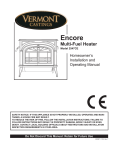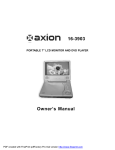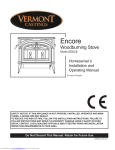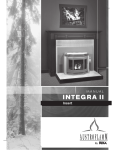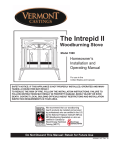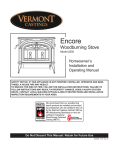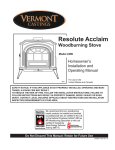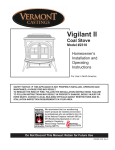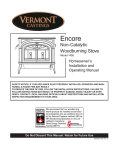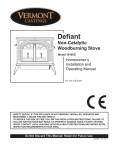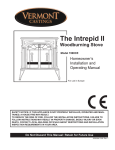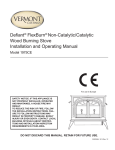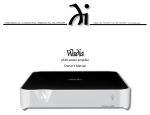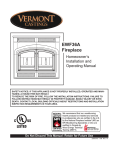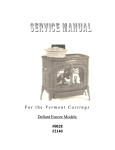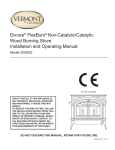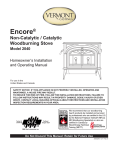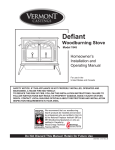Download Vermont Casting 2547CE Indoor Fireplace User Manual
Transcript
Encore
Multi-Fuel Heater
Model 2547CE
Homeowner’s
Installation and
Operating Manual
0971
Encore
Multi-Fuel
cover
9/02
SAFETY NOTICE: IF THIS APPLIANCE IS NOT PROPERLY INSTALLED, OPERATED AND MAINTAINED, A HOUSE FIRE MAY RESULT.
TO REDUCE THE RISK OF FIRE, FOLLOW THE INSTALLATION INSTRUCTIONS. FAILURE TO
FOLLOW INSTRUCTIONS MAY RESULT IN PROPERTY DAMAGE, BODILY INJURY OR EVEN
DEATH. CONTACT LOCAL BUILDING OFFICIALS ABOUT RESTRICTIONS AND INSTALLATION
INSPECTION REQUIREMENTS IN YOUR AREA.
Do Not Discard This Manual: Retain for Future Use
2000971 5/07 Rev. 5
Encore Multi-Fuel Heater
Welcome
Congratulations on your choice of a Vermont Castings Encore Multi-Fuel Heater. With this purchase you have made a
commitment to make the hearth a place of warmth, beauty, and comfort in your home. At CFM Corporation, we share
that joy and appreciation for the hearth. You may be assured that your cast-iron Vermont Castings stove has been
made with the utmost care and will provide you with many years of service.
At Vermont Castings, we are equally committed to your satisfaction as a customer. That is why we maintain an exclusive network of the finest dealers in the industry. Our dealers are chosen for their expertise and dedication to customer service. They are factory-trained and knowledgeable about every Vermont Castings product. Feel free to contact
your Authorized Vermont Castings Dealer anytime you have a particular question about your stove or its performance.
This manual contains valuable instructions on the installation and operation of your Vermont Castings stove. It also
contains useful information on maintenance and assembly of this product. We urge you to read the manual thoroughly
and to keep it as a reference.
Sincerely,
All of us at CFM Corporation
The Encore Multi-Fuel 2547CE is designed for burning
wood and most smokeless solid fuels.
Consult a professional, solid fuel service person to
install your stove, or to advise you on the installation
should you wish to install it yourself.
Please read the entire manual before you install and
use your new room heater. Failure to follow instructions
may result in property damage, bodily injury, or death.
Table of Contents
Specifications ................................. 3
Installation ...................................... 4
Assembly .......................................11
Operation ...................................... 12
Draft Management ........................ 17
Maintenance ................................. 19
Replacement Parts ....................... 23
Warranty ....................................... 27
2
2000971
Encore Multi-Fuel Heater
Specifications
Encore Multi-Fuel, Model 2547CE
Wood
Smokeless Fuel2
1
Nominal heat output
12.3 kW
7.7 kW1
(42,000 BTU/hr) (26,270 BTU/hr)
Minimum flue draught
12 Pa
12Pa
(0.048” WG)
(0.048”WG)
Mean flue gas temp
291°C (556°F)
267°C (513°F)
Efficiency (space heating)
71.6%
66.7%
Fuel size/type
up to 510 mm (20”) Smokeless coal
Flue mass gas flow
12.0 g/s
10.4 g/s
CO Emissions (@ 13% O2) 7900 ppm
3200 ppm
Area Heated .............................. 129 sq. m (1400 sq.ft.)
Loading ....................................................... Front or top
Chimney connector:
for 8” flue collar ....................... 203 mm (8”) diameter
for 6” flue collar ....................... 152 mm (6”) diameter
Chimney flue size:
for 8” flue collar .......................203 mm (8”) minimum
for 6” flue collar .......................152 mm (6”) minimum
Flue exit position ....................... Reversible, top or rear
Primary air ... Manually set, thermostatically maintained
Ash handling system ..................... Removable ash pan
Glass panel ......................... High-temperature ceramic
Weight ................................................ 159 kg (350 lbs.)
Width (leg-to-leg) ..................................... 685 mm (27”)
Depth (leg-to-leg) .................................... 380 mm (15”)
Height to top of flue collar, 152 or 203 mm (6” or 8”)
Top exit .............................................. 640 mm (25¹⁄₄”)
Rear exit ............................................ 675 mm (26¹⁄₂”)
1. This value can vary depending on how the stove
is operated, the type and moisture content of the fuel
used, as well as the design, construction and climatic
location of your home. Figures shown are based on
nominal fuel consumption obtained under laboratory
conditions and on average efficiencies.
2. This stove is approved for use with processed coal
fuels generally known as smokeless. Ask your dealer
which fuels are acceptable in your area.
Drawings Not to Scale
457 mm (18")
83 mm
(3���")
543 mm
(21���")
610 mm
(24")
686 mm (27")
51 mm
(2")
394 mm
(15���")
686 mm (27")
470 mm
(18���")
572 mm (22���")
641 mm
(25���")
Top exit
flue collar
height
657 mm
(25���")
127 mm
(5")
73 mm (2���")
600 mm
(23���")
187 mm
(7���")
133 mm
(5���")
686 mm (27")
381 mm
(15")
0971
Fig. 1 Encore MF dimensions.
����
Encore MF 2547
dimensions
9/02
2000971
3
Encore Multi-Fuel Heater
Installation
• Your stove and chimney connector will be far
•
•
enough from combustible material to meet all clearance requirements.
The hearth is large enough and is constructed properly to meet all requirements.
You have all necessary permits from local authorities.
Your local building official is the final authority for approving your installation as safe and determining that it
meets local and state codes.
The metal label permanently attached to the back of every Vermont Castings stove indicates that the stove has
been tested to current standards. The test standards
are UL 1482 and Ul 737 for the US and EN13240:2001
+ A2:2004 for Europe. Clearance and installation information also is printed on the label. When the stove is
installed according to the information both on the label
and in this manual, local authorities in most cases will
accept the label as evidence that the installation meets
codes and can be approved.
However, codes vary in different countries. Before
starting the installation, review your plans with the local
building authority. You local dealer can provide any additional information needed.
IMPORTANT: FAILURE TO FOLLOW THESE INSTALLATION INSTRUCTIONS MAY RESULT IN A
DANGEROUS SITUATION, INCLUDING A CHIMNEY
OR HOUSE FIRE. FOLLOW ALL INSTRUCTIONS
EXACTLY, AND DO NOT ALLOW MAKESHIFT COMPROMISES TO ENDANGER PROPERTY AND PERSONAL SAFETY.
Outside Air
In some modern, super-insulated homes, there is
inadequate air for combustion because of insufficient
air infiltration into the building. Such air enters a home
through unsealed cracks and openings. Exhaust fans
for kitchen or bath can compete with the stove for available air and compound the problem.
When poor draft is caused by a low infiltration rate,
opening a ground floor window on the windward side
of the house and in the vicinity of the stove will usually
alleviate the problem.
Another solution is to install a permanent outside air
supply to the stove and/or room. In fact, bringing air
for combustion from outside the home directly to the
air inlet of the stove is required for new construction in
some areas.
Pressure variations within the house do not affect a
stove equipped with an outside air supply, and improved stove performance often results. An Outside Air
Adapter Kit for the Encore Multi-Fuel is available from
your local Vermont Castings dealer.
Chimney Height
Altitude affects chimney performance. When using a
152 mm (6”) flue collar on the Encore Multi-Fuel, refer
to Figure 2 for suggested chimney heights at various
altitudes. Chimney height should be measured from the
flue collar to the top of the chimney. The recommended
minimum chimney height is 4.9 m (16’).
30
25
Height
SAFETY NOTICE: IF YOUR ENCORE IS NOT PROPERLY INSTALLED, A HOUSE FIRE MAY RESULT.
TO REDUCE THE RISK OF FIRE, FOLLOW THE
INSTALLATION INSTRUCTIONS. CONTACT LOCAL
BUILDING OR FIRE OFFICIALS ABOUT RESTRICTIONS AND INSTALLATION INSPECTION REQUIREMENTS IN YOUR AREA.
Before you begin an installation, be sure that:
20
15
0
ST491
2000
4000
6000
8000
10000
12000
Altitude
Fig. 2 Chimney height requirements for Encore MF when
equipped with a 152 mm (6”) chimney.
4
ST491
Defiant
chimney height
11/2/00 djt
2000971
Encore Multi-Fuel Heater
What Kind of Chimney to Use
Prefabricated Chimneys
You must connect the Encore Multi-Fuel to a code-approved masonry chimney with a flue liner, to a relined
masonry chimney that meets local codes, or to a
prefabricated metal chimney. (Fig. 3) The chimney and
chimney connector must be in good condition and kept
clean.
These should be an internal diameter of 150 mm (6”)
and be of the twin wall insulated construction that has
been approved for solid fuel use (e.g. Rite Vent ICS of
ICID Lite Chimney Systems). Diameters over 200 mm
(8”) are not recommended due to the large cross-section causing excessive cooling of the flue gases.
If you use an existing masonry chimney, it must be
inspected to ensure it is in a safe condition before
the stove is installed. Your local professional chimney
sweep, building inspector, or fire department official will
be able to inspect the chimney or provide a referral to
someone who can.
DO NOT CONNECT THIS UNIT TO A CHIMNEY FLUE
SERVING ANOTHER APPLIANCE.
A prefabricated doublewall insulated chimney
An Encore Multi-Fuel with an 203 mm (8”) flue collar is
sized for venting into a masonry chimney with a nominal
flue size of 8” x 8” (203 x 203 mm) or 8” x 12” (203 x
305 mm), and into a round flue with nominal flue size of
8” (203 mm). An Encore Multi-Fuel with a 6” (152 mm)
flue collar is approved for venting into a masonry chimney with a nominal flue size of 8” x 8” (203 x 203 mm),
and into a round flue with nominal flue of 6” (152 mm).
NOTE: When installed with a 6” flue collar, the
Encore Multi-Fuel is not recommended for use with
the front doors open.
A tile-lined
masonry
chimney
ST241
Fig. 3 Approved chimney types.
Masonry Chimneys
ST241
An inspection of the
chimney
chimney
types must confirm that it has
12/13/99
djt
a lining. Do not use
an unlined
chimney. The chimney
should have no cracks, loose mortar, other signs of
deterioration, and blockage. Repair any defects before
the chimney is used with your stove.
Unused openings in an existing masonry chimney must
be sealed with masonry to the thickness of the chimney
wall, and the chimney liner should be repaired. Openings sealed with pie plates or wallpaper are a hazard
and should be sealed with mortar or refractory cement.
In the event of a chimney fire, flames and smoke may
be forced out of these unused thimbles.
The chimney should be thoroughly cleaned before use.
A newly-built masonry chimney must conform to the
standards of your local building code or, in the absence
of a local code, to a recognized national code. Masonry
chimneys must be lined, either with code-approved
masonry or pre-cast refractory tiles, stainless steel
pipe, or a code-approved, “poured-in-place” liner. The
chimney’s clean-out door must seal tightly.
2000971
Chimney Size
Whatever the flue collar size, an Encore Multi-Fuel
may be vented into larger chimneys as well. However, chimneys with liners larger than 203 x 305 mm
(8” x 12”) may experience rapid cooling of smoke and
reduction in draft, especially if the chimneys are located
outside the home. These large chimneys may need to
be insulated or have their flues relined for proper stove
performance.
Accessories to help make the connection between
stainless steel chimney liners and your Encore MultiFuel are available through your local dealer.
Chimney Connector Guidelines
A chimney connector is the double-wall or single-wall
pipe that connects the stove to the chimney. The chimney itself is the masonry or prefabricated structure that
encloses the flue. Chimney connectors are used only to
connect the stove to the chimney, as in Figure 6.
Connecting Flue Pipes
Connector pipes should meet the requirements of the
building regulations. This can be achieved by the use
connecting fluepipes included in the following categories:
a) Vitreous enamelled steel pipe complying with BS
6999: 1989 (1996);
b) Pipes made from stainless steel as descirbed in BS
EN 1008-1:1995 grades 1.4401, 1.4404, 1.4432 or
1.4436 with flue wall thickness of at least 1 mm;
c) Mild steel fluepipes complying with BS 1449: Part 1:
1991, with a flue wall thickness of at least 3 mm;
d) Cast iron fluepipes complying with BS 41: 1973
(1998).
5
Encore Multi-Fuel Heater
Flue Pipes with a spigot and socket joint should be
fitted with the socket facing upwards, to contain condensates and moisture within the flue. Joints should be
made gas tight using proprietary jointing accessories,
or, where appropriate, by packing joint with noncombustible rope and fire cement.
Double-wall connectors must be tested and listed for
use with solid-fuel burning appliances. Single-wall connectors should be made of 24 gauge or heavier steel.
Do not use galvanized connector; it cannot withstand
the high temperatures that can be reached by smoke
and exhaust gases, and may release toxic fumes under
high heat. The connector may be 152 mm (6”) or 203
mm (8”) in diameter.
If possible, do not pass the chimney connector through
a combustible wall or ceiling. If passage through a combustible wall is unavoidable, refer to the section on Wall
Pass-Throughs. Do not pass the connector through an
attic, a closet or similar concealed space. The whole
connector should be exposed and accessible for inspection and cleaning.
The recommended maximum length of a horizontal
stovepipe run is 152 mm (6”).
In cathedral ceiling installations, extend the prefabricated chimney downward to within 2.4 m (8’) of the stove.
Wear gloves and protective eyewear when drilling,
cutting or joining sections of chimney connector.
Double-wall Chimney Connectors
Information on assembling and installing double-wall
connectors is provided by the manufacturer of the
double-wall pipe. Follow the manufacturer’s instructions
exactly as you assemble the connector and attach it to
the stove and chimney. Using chimneys and connectors
from the same manufacturer makes the assembly and
installation straightforward.
NOTE: For installations using double-wall connectors,
minimum clearances must conform to the listed clearances in the clearance chart on Page 13.
If the Encore Multi-Fuel is equipped with the 203 mm
(8”) flue collar, an oval-to-round adapter will be needed.
Your local dealer can help you select the right connector.
Single-wall Chimney Connectors
• Begin assembly at the flue collar of the stove. Insert
the first crimped end into the stove’s flue collar. Keep
each crimped end pointing toward the stove. (Fig. 5)
Using the holes in the flue collar as guides, drill 3 mm
(1/8”) holes in the bottom of the first section of chimney
connector and secure it to the flue collar with three #10
x 1/2” sheet metal screws.
• Secure each joint between sections of chimney connector, including telescoping joints, with at least three
6
sheet metal screws. The
pre-drilled holes in the top
of each section of chimney
connector serve as guides
when you drill 3 mm (1/8”)
holes in the bottom of the
next section.
• Secure the chimney
connector to the chimney.
Instructions for various installations follow.
Fig. 4 the crimped end
• Be sure the installed
of the connector
points
ST242
connector
towardChimney
stove.
stove and chimney connec12/13/99 djt
tor are correct distances
from nearby combustible materials.
NOTE: Special slip pipes and thimble sleeves that form
telescoping joints between sections of chimney connector are available to simplify installations. They often
eliminate the need to cut individual connector sections.
Consult your local dealer about these special pieces.
Securing the Single-wall Connector to a
Prefabricated Chimney
Follow the installation instructions of the chimney
manufacturer exactly as you install the chimney. The
manufacturer of the chimney will supply the accessories to support the chimney, either from the roof of the
house, at the ceiling of the room where the stove is
installed, or from an exterior wall.
Special adapters are available from your local dealer
to make the connection between the prefabricated
chimney and the chimney connector. The top of such
adapters attaches directly to the chimney or to the
chimney’s ceiling support package, while the bottom of
the adapter is screwed to the chimney connector.
These adapters are designed so the top end will fit
outside the inner wall of the chimney, and the bottom
end will fit inside the first section of chimney connector.
When assembled in this way, any soot or creosote falling from the inner walls of the chimney will stay inside
the chimney connector.
Securing the Single-wall Connector to a
Masonry Chimney
Both freestanding masonry chimneys and fireplace masonry chimneys may be used for your installation.
Freestanding Installations
If the chimney connector must pass through a combustible wall to reach the chimney, follow the recommendations in the Wall Pass-Through section that follows.
The opening through the chimney wall to the flue
(the “breech”) must be lined with either a ceramic or
metal cylinder, called the “thimble”, which is cemented
2000971
Encore Multi-Fuel Heater
Chimney
Flue
Elbow
Flue Liner
Without a thimble, a suitable length of chimney connector can be extended through the breech to the inner
face of the flue liner, and cemented securely in place.
Additional pieces of connector are then attached with
sheet metal screws.
Fireplace Installations
Slip Pipe
The chimney connector may be connected to the
chimney above the fireplace opening or through the
fireplace.
Thimble
Standard
Connector
Oval to
Round Adapter
Above the Fireplace
Flue Collar
ST492
The Encore Multi-Fuel may be connected to a chimney
above a fireplace opening. (Fig. 7) In such installations, the stove is positioned on the hearth in front of
the fireplace and the chimney connector rises from the
stove top and then angles ninety degrees back into the
chimney. The chimney liner should extend to the point
at which the chimney connector enters the chimney.
Fig. 5 An exploded view of the chimney connection in a freestanding masonry installation.
ST492
securely in place. MostDefiant
chimney breeches incorporate
freestanding
thimbles, but the fit must
be snug and the joint between
installation
the thimble and the chimney
wall must be cemented
11/00
firmly.
A special piece called the “thimble sleeve,” slightly
smaller in diameter than standard connectors and most
thimbles, will facilitate the removal of the chimney connector system for inspection and cleaning. Thimble
sleeves should be available from your local dealer.
To install a thimble sleeve, slide it into the breech until
it is flush with the inner flue wall. Do not extend it into
the actual flue passage, as this could interfere with the
draft.
The thimble sleeve should protrude 25-51 mm (1-2”)
into the room. (Fig. 6) Use furnace cement and thin
gasketing to seal the sleeve in place in the thimble.
Secure the chimney connector to the outer end of the
sleeve with sheet metal screws.
Thimble
Thimble Sleeve
Chimney Connector
45° Elbow
Maximum
Flue
ST243a
Fig. 6 The thimble, made of either ceramic or metal, must be
cemented securely in place.
*
* Check these
clearances
Chimney Connector Shield
Mantel
*
Seal the
Damper
ST244a
Fig. 7 Chimney connector enters chimney above the fireplace opening.
ST244a
If the chimney connector
from your installation enters
Intrepid MF follow all the guidelines
the chimney above a fireplace,
fplc over mantel
mentioned above for freestanding
installations. In addi2/01
tion, give special consideration to the following points:
• Check the clearance between the stove and the
chimney connector, and any combustible trim or the
mantel. Use the necessary combination of mantel,
trim, and connector heat shields to achieve the required
clearances.
• Check the clearance between the chimney connector and the ceiling. If no heat shields are used, the
clearance should be at least 24” (610 mm). To find out
how much this clearance may be reduced with heat
shields, see the clearance chart on Page 14.
7
2000971
ST243a
45 degree
Encore Multi-Fuel Heater
• The fireplace damper must be sealed to prevent
room air from escaping up the flue. However, it must
be possible to reopen the damper to inspect or clean
the chimney.
Through the Fireplace
If your fireplace opening height is at least 26¹⁄₂"
(675mm), you may install an Encore Multi-Fuel through
the opening using a “positive connection” kit, available
from your local dealer. These positive connection kits
ensure a tight fit between the stove flue collar and the
chimney flue. (Fig. 8)
Always adhere to local building codes when installing a
wall pass-through. Figure 9 shows one recommended
method.
All combustible material in the wall must be removed
around the single-wall connector to provide clearance
that is three times the pipe diameter. Any material used
to enclose the opening must be noncombustible.
Fireplace installations, whether connected to the flue
above or through the fireplace opening, have special
clearance requirements to adjacent trim and the mantel.
Figure 9 shows another method of passing a connector
through a wall. All combustible material in the wall is cut
away to provide the required clearance that is 3x the
connector diameter. The resulting space must remain
empty. A flush-mounted sheet metal cover may be used
on one side only. If covers must be used on both sides,
each cover must be mounted on noncombustible spacers at least 25 mm (1”) clear of the wall.
Floor protection requirements also apply to fireplace
installations. Refer to “Floor Protection” section.
DO NOT CONNECT AN ENCORE MULTI-FUEL TO
ANY AIR DISTRIBUTION SYSTEM.
Flexible Connector
T
Mantel Shield
Fireplace Adapter
Kit “Positive Connection”
ST494
Fig. 9 A hollow wall pass-through method.
ST245
Fig. 8 In this installation, the chimney connector enters the
firepalce opening and then connects to the chimney.
ST245
Wall Pass-Throughs
fireplace
flex connector
Whenever possible, design
your installation so the con12/99
nector does not pass through a combustible wall. If you
are considering a wall pass-through in your installation,
check with your building inspector before you begin.
Also, check with the chimney connector manufacturer
for any specific requirements. Some manufacturers
make chimney components that may be used as wall
pass-throughs. If using one of these, make sure it has
been tested and listed for use as a wall pass-through.
ST494
Hearths
steel
This appliance must be wall
installed
on to hearth that
pass thru
meets the requirements 11/00
of Part J of the Building Regulations 2000 (Combustion Appliances and Fuel Storage
Systems). This can be achieved by ensuring that the
hearth is constructed and sized in accordance with the
guidelines included in section 2 of approved document
‘J’. The size and clearances of the hearth are as follows:
The constructed hearth should be constructed in accordance with the recommendations in document J,
and should be of minimum width 840 mm and minimum
depth 840 mm (if a free standing hearth b) above) or
a minimum projection of 150 mm from the jamb (if a
recessed hearth a) above).
Unless the stove hearth is completely noncombustible,
the bottom heat shield should be installed to provide
radiant protection for framing which may be below the
hearth. (Fig. 11)
8
2000971
Encore Multi-Fuel Heater
Costructional Hearth
Dimensions as below
At least 150 mm
or to a suitable
heat resistant wall
Appliance
Appliance
Doors
Doors
Hearth Surface
Free of Combustible Material
At least
150 mm
Perimeter should be
clearly marked e.g.
edge of superimposed
hearth
Perimeter should be
clearly marked e.g.
edge of superimposed
hearth
At least
300 mm
a) Fireplace recess
b) Free standing
Fig. 10 Noncombustible hearth surface dimensions.
ST912
Keep the Stove a Safe Distance
from Surrounding Materials
Both a stove and its chimney connector radiate heat in
all directions when operating, and dangerous overheating of nearby combustible materials can occur if they
are too close to the heat. A safe installation requires
that adequate clearance be maintained between the
hot stove and its connector and nearby combustibles.
Wood framing requires protection from radiant heat
ST247e
Fig. 11 Combustible supporting timbers may lie beneath
fireplace hearths, reqireimg additional floor protection.
Floor Protection for Fireplace Installations
Clearance is the distance between either your stove
(measured from the bottom edge of the stove’s top
plate) or chimney connector, and nearby walls, floors,
the ceiling, and any other fixed combustible surface.
Your stove has special clearance requirements that
have been established after careful research and testing to both US and European standards. These clearance requirements must be strictly observed.
Do not assume that your fireplace hearth is completely
ST247
noncombustible.
Rear exit floor dgrm
Many fireplace hearths do not meet the “completely
12/14/99 djt
noncombustible” requirement because the brick or
concrete in front of the fireplace opening is supported
by heavy wood framing. (Fig. 11) Because heat passes
through brick or concrete readily, it can easily pass
through to the wood. As a result, such fireplace hearths
can be a fire hazard and are considered a combustible
floor.
In addition, furnishings and other combustible materials
must be kept away from the stove as well. In general, a
distance of 1219 mm (48”) must be maintained between
the stove and moveable combustible items such as drying clothes, furniture, newspapers, firewood, etc. Keeping those clearance areas empty assures that nearby
surfaces and objects will not overheat.
Keep in mind, also, that many raised hearths will extend
less than the required clearance from the front of the
heater when it is installed. In such cases, sufficient
floor protection as described above must be added in
front of the hearth to satisfy the minimum floor protector
requirement from the front of the stove: 406 mm (16”)
from the front.
As with any solid fuel heating stove, extremely high
surface temperatures can occur, particularly in the
event of uncontrolled operation, e.g. if the doors
are inadvertently left open. It is crucial that sufficient clearances are allowed to any combustible
surfaces, e.g. wooden mantels or lintels, and to
timber framed (studded) walls even if they are faced
with noncombustible board. Detailed information
on fireplace and hearth construction is provided
Hearth rugs do not satisfy the requirements for floor
protection.
2000971
Safe Ways to Reduce Clearances
Clearances
9
Encore Multi-Fuel Heater
in section 2 of Document J, all installations must
comply with these requirements or with the relevant
National or local building standards.
Clearances to timber framed (studded) walls are included below. There are no specific minimum clearances to solid noncombustible surfaces (e.g. the sides and
rear of Inglenook fire openings constructed from solid
masonry) other than to allow safe access to the controls
of the stove. For this reason minimum side clearances
of 125 mm, and a minimum rear clearance of 50 mm
are recommended.
Summary of Clearances
Minimum recommended side clearances to noncombustible surfaces 125 mm (5”).
Minimum recommended rear clearance to noncombustible surfaces 50 mm (2”).
NOTE: The minimum thickness of solid noncombustible materials is specified in section 2 of Document ‘J’,
in relation to the clearance of the appliance from the
surface. As a general rule, the thickness of solid noncombustible material forming the recess of a fireplace is
a minimum of 200 mm.
Minimum rear clearance from combustible walls
(e.g. timber framed or studded walls) 840 mm (33”)
measured from the rear edge of the stove top. (Fig.
12, B)
at least
3xD
B
A
ST486a
Fig. 12 Minimum clearances.
Minimum side clearance from combustible walls
610 mm (24”) measured
from the side edge of the
ST486a
stove top. (Fig. 12, Defiant
A)
EU
Minimum distance Clearance
from stove to movable combustible materials (e.g. furniture, drying clothes, etc.)
Diagrams
1220 mm (48”).
10/06
Connecting Flue Pipe - Clearances
Single wall connecting fluepipes can reach extremely
high temperatures; therefore, clearances from the connecting fluepipe (chimney connector) must comply with
the requirements of Part J of Building Regulations 2000
(Combustion Appliances and Fuel Storage Systems).
This can be achieved by following the recommendations of Approved Document ‘J’. These are as shown in
Figure 13.
at least 3 x D
D
at least
1.5 x D
D
at
3 lea
x st
D
at least
1.5 x D
Fluepipe
at least
1.5 x D
at least
1.5 x D
at least 1.5
xD
Elevation
Without
Shield
Plan Without
Shield
Elevation
With Shield
Air space of at least 12 mm
between noncombustible shield
and combustible material
Plan With
Shield
ST911
Fig. 13 Connecting fluepipe clearances.
10
�����
�������������������
�����
2000971
Encore Multi-Fuel Heater
Assembly
Set Up Your Stove
Cast iron stoves are heavy, and it will take two to four
people to move your Encore MF into position.
Wash the protective coating of oil from the griddle with
soap and water. Dry the griddle thoroughly and apply a
light coating of vegetable oil to season the surface and
help prevent rust.
Remove all packing materials from inside the stove.
Install the Optional Bottom Heat Shield
1. Remove the four 10-24 x 1/2” hex head bolts from
the corners of the ash drop on the stove bottom.
2. Screw the four 32 mm (1¹⁄₄") spacers into the holes
from which you removed the bolts, finger-tight.
3. Align the bottom heat shield against the spacers with
the stepped side toward the rear of the stove.
4. Secure the shield with the four hex head bolts previously removed from the stove bottom.
5. Tighten securely.
Spacers
ST634
Fig. 15 Use spacers and screws to position the ashdoor heat
shield.
ST634
Attach the Primary
Encore Air Thermostat Handle
The primary airashdoor
thermostatshield
handle is the smaller of the
two black handles.
2/01Secure the handle to the stub on
the right side of the stove with an 8-32 x 2” slot head
machine screw.
ST635
Fig. 16 Attach thermostat handle.
ST633
Fig. 14 Use four spacers to attach the bottom heat shield.
Adjust the Leg Levellers
Lift the stove slightly so there is no weight on the leg
while making the adjustment.
Reverse the Flue
Collar (If Necessary)
ST633
Encore
Reverse the flue collar by
removing the two screws that
Bottom
Heat
attach it to the back of the
stove.
Be Shield
sure the gasket
2/01
around the flue collar opening is in position when you
screw the collar back onto the stove.
Install the Ash Door Heat Shield
1. Remove the two Phillips pan head screws from the
ash door.
2. Insert the screws through the ash door heat shield
(from the painted side), place the 8 mm (5/16”)
spacers over the screws, and carefully thread them
back into the original holes. The curved lip should be
upward, under the ashlip of the stove.
3. Tighten securely.
2000971
Attach the Damper Handle
ST635
Use the 1/4” -20 x 3” screw
to attach the damper handle
Encore
to the damper stub on the
left side.
Install thermostat
Assemble the Removable
Insert Handle
handle
The white removable 2/01
insert handle opens
and closes the front
doors. Remove after
each use so it won’t
get hot, and store it in
the handle holder installed behind the right
front leg. Assemble
ST540
the handle by passFig. 17 Assemble the front
ing the 86 mm (3³⁄₈")
door handle.
screw through the
ceramic shaft and into
the bright metal nub. Tighten carefully until snug.
ST540
Assembly
handle
11/00
11
Encore Multi-Fuel Heater
Operation
�
�������
A Damper Directs Air Flow
Within the Stove
��������������
������������
������������������
�������������
��������������������
���������������
The Encore Multi-Fuel Controls
Two controls regulate the performance of the Encore:
a primary air control supplies oxygen for the fire, and
a damper directs air flow within the stove or directly up
the vent.
The damper handle on the left side of the stove opens
and closes the damper to direct air flow within the
stove.
The damper is open when the handle points to the back
of the stove, enabling smoke to pass directly into the
chimney. The damper must be open when starting or
reviving a fire, and whenever the griddle or doors are
opened.
Low Heat
Symbols cast into the stove are reminders of the correct
directions for opening and closing the controls.
Damper Handle
Griddle Handle
Door Handle
Air Control
Lever
High Heat
ST637
Door Handle
Holder (Behind leg)
Ashdoor
Handle
Andirons
ST636
Fig. 18 The Encore controls are conveniently located and
easy to operate.
ST633
A Single Air Control Regulates
Encore
Heat Output and Burn Time
controls
The primary air control lever, located on the right side
2/01
of the stove, controls the amount of incoming air for
starting, maintaining, and reviving a fire.
More air entering the stove makes the fire burn hotter
and faster, while less air prolongs the burn at a lower
heat level. High and low settings appear in Figure 19.
For the greatest air supply and maximum heat output
(but the shortest burn time), move the lever toward the
front of the stove. For a fire that will last longer with less
heat, move the lever toward the rear of the stove.
12
Fig. 19 The handle may be positioned anywhere between the
two extremes for different heat levels.
The damper is closed when the handle points forward.
Exhaust gases are directed around the rear baffle before passing up the chimney.
When closing the damper, be sure to pull firmly
enough to snap it into the locked position.
ST637
Damper Positions
encore
Air control
2/01
Open
(Updraft Mode)
Closed
(Bypass Mode)
ST638
Fig. 20 The damper is either open or closed. There are no
intermediate positions.
ST638
Encore
2000971
damper control
2/01
Encore Multi-Fuel Heater
Two Ways to Add Fuel
The Encore’s griddle lifts for convenient top-loading of
fuel, and is the easiest way to regularly add fuel.
In addition, however, the front doors open for adding an
occasional log to a fire. The Encore is not approved
in Europe for operation with the front doors open.
To open the front doors, insert the handle into the door
latch stub and turn it to the left and up. (Fig. 22)
Handle
Infrared Reflective Glass Panels
for Clear Fire Viewing
The inner surfaces of the infrared reflective glass
panels are kept at a higher temperature than the outer
surface. This design, along with a preheated ‘airwash,’
makes clear fire viewing possible at most levels of
operation.
Burn Only High-Quality Fuel
The Encore is designed to burn natural wood and
smokeless coal.
You’ll enjoy the best results when burning wood that
has been adequately air-dried. Avoid burning “green”
wood that has not been properly seasoned, or cordwood dried more than two years. Do not burn construction materials; they often contain chemicals and
metals that can damage the iron over time. The wood
should be 457-508 mm (18-20”) in length.
ST639
Fig. 21 The Encore’s hinged griddle makes it easy to top-load
wood.
Clockwise to
OPEN
Counterclockwise
to CLOSE
The best hardwood fuels include oak, maple, beech,
ash, and hickory that has been split, stacked, and airdried outside under cover for at least one year.
If hardwood is not available, you can burn softwoods
like include tamarack, yellow pine, white pine, Eastern
red cedar, fir, and redwood. These too should be properly dried.
Store wood under cover to keep it dry. The longer it is
stored, the better heating and fire viewing performance
you will enjoy. Even for short-term storage, however,
keep all fuels a safe distance from the heater and keep
it out of the areas around the heater used for refueling
and ash removal.
�����
������������
����
ST544
Fig. 22 To open the front doors, turn the handle clockwise.
A Surface Thermometer is a Valuable
Guide to Operation
An optional surface thermometer lets you know when to
adjust the air control and when to refuel.
To close them, always close the left door first. Turn the
handle in the right door to the left and up (to the open
position) and close it. Finally, push on the door as you
turn the handle to the right and down. The doors will
draw in slightly, and the handle should offer some resistance as you turn it to the closed position.
To reduce the risk of breaking the glass, avoid striking
the glass or slamming the doors.
When not using the door handle, store it in the holder
behind the right front leg of the stove.
ST544
This stove is designed to operate
efficiently with
the fire doors (front doors and griddle) closed. The
door open
firebox and ash doors should be kept closed at all
times except when refuelling or
removing ashes.
11/00
2000971
ST523
Fig. 23 Take temperature readings with the thermometer
located in the middle of the griddle.
For example, when the thermometer registers at least
230° C (450° F) after start-up you know the stove is
hot enough to begin catalytic combustion and it may
be time to close the damper. Note that the stove will
warm up much sooner than the chimney, though; a
warm chimney is the key to easy, effective stove operation. Please review the draft management information
13
Encore Multi-Fuel Heater
on Page 17 to see how the size, type, and location of
your chimney will affect your stove operation. When
thermometer readings drop below 175° C (350° F) it’s
time to adjust the air control for a higher burn rate or to
reload the stove. A temperature reading over 385° C
(750° F) is a sign to cut back on the air supply to slow
the burn rate.
Your Encore will accept a duct to deliver outside air for
combustion.
Use the following temperature ranges as a guide to
operation:
Most installations do not require a large amount of
combustion air, especially if adequate draft is available.
Do not for any reason attempt to increase the firing
of your heater by altering the air control adjustment
range outlined in these directions.
• Readings in the 175°-260° C (350-500° F) range
•
•
indicate low to medium heat output.
260°-315° C (500-600° F) readings indicate medium
heat output.
Readings of 315°-400° C (600-750° F) indicate high
heat output. Operating your Encore continuously at
griddle temperatures of 385° C (750° F) or higher
may damage the cast iron or enamel finish.
Use the Air Control Settings
that Work Best for You
No single air control setting will fit every situation. Each
installation will differ depending on the quality of the
fuel, the amount of heat desired, and how long you wish
the fire to burn; outdoor air temperature and pressure
also affect draft.
The control setting also depends on your particular
installation’s “draft,” or the force that moves air from the
stove up through the chimney. Draft is affected by such
things as the length, type, and location of the chimney,
local geography, nearby obstructions, and other factors.
Refer to Page 23 for details on how the installation affects performance.
Too much draft may cause excessive temperatures in
the Encore, and could even damage the combustor.
On the other hand, too little draft can cause backpuffing
into the room and/or the “plugging” of the chimney or
combustor.
How do you know if your draft is excessively high or
low? Symptoms of too much draft include an uncontrollable burn or a glowing-red stove part. A sign of inadequate draft is smoke leaking into the room through the
stove or chimney connector joints, low heat, and dirty
glass.
In some newer homes that are well-insulated and
weather-tight, poor draft may result from insufficient air
in the house. In such instances, an open window near
the stove on the windward side of the house will provide
the fresh air needed.
In some areas provisions for outside combustion air
are required. Refer to section 2 of Document J which
requires an outside air vent for appliances with power
outputs over 5 kW. Always refer to national and local
codes to determine your specific requirements.
14
When first using the stove, keep track of the air control
settings. You will quickly find that a specific setting will
give you a fixed amount of heat. It may take a week or
two to determine the amount of heat and the length of
burn you should expect from various settings.
Use the following air control settings as a starting point
to help determine the best settings for your installation.
Each is described as a fraction of the total distance the
lever may be moved from right to left.
Encore Control Settings
Burn Rate
Low
Medium
High
Primary Air Control
From far right to 1/3
the distance to left
From 1/3 to 2/3 the distance
to left
From 2/3 the distance
to left to far left
Conditioning Your Stove
Cast iron is extremely strong, but it can be broken with
a sharp blow from a hammer or from the thermal shock
of rapid and extreme temperature change.
The cast plates expand and contract with changes in
temperature. When you first begin using your Encore,
minimize thermal stress by allowing the plates to adjust
gradually during three or four initial break-in fires following Steps 1-3 below.
Starting and Maintaining a Fire
Burn wood or coal directly on the grate. Do not elevate
the fuel.
The damper must be open when starting a fire or
when refueling.
Do not use chemicals or fluids to start the fire. Do
not burn garbage or flammable fluids such as gasoline, naptha, or engine oil.
1. Open the stove damper, and open the primary air
control fully.
2. Place several sheets of crumpled newspaper in the
stove. Place on the paper six or eight pieces of dry
kindling split to a finger-width size, and on the kindling lay two or three larger sticks of split dry wood
approximately 25-51 mm (1-2”) in diameter.
Never use gasoline-type lantern fuel, kerosene, charcoal lighter fluid, or similar liquids to start or “freshen
2000971
Encore Multi-Fuel Heater
burning wood, continue adding split logs of this size
to the briskly-burning fire until there is a glowing
ember bed at least 76 mm (3”) deep. If burning coal,
begin adding small amount directly on the kindling to
establish a burning coal pile.
5. Close the damper when the griddle temperature
reaches 230° C (450° F).
6. Adjust the air control for your desired heat output.
Refuel While the Embers Are Still Hot
ST263
Fig. 24 Start fire with newspaper and dry kindling.
up” a fire. Keep all such liquids well away from the
Encore while it is in use.
3. Light the newspaper
ST263 and close the door. Gradually
build up the fire
by adding
starting
a firea few 76-127 mm (3-5”)
diameter splits.
If
this
is
one of the first few “break12/99
in” fires, let the fire burn brightly, and then let it die
out.
During the break-in fires, don’t let the stove get hotter than 260° C (500° F) as measured on an optional
stove-top thermometer. Adjust the air control lever as
necessary to control the fire.
Some odor from the stove’s hot metal, the paint, and
the cement is normal for the first few fires.
NOTE: Some chimneys need to be “primed,” or
warmed up, before they will draw sufficiently to start
a fire. To correct this situation, roll up a couple pieces
of newspaper, place them on top of the kindling and
toward the back of the stove, light them, and close
the doors. This will encourage smoke to rise rapidly,
encouraging a good draft.
Once the draft is established, open the front door and
light the rest of the fuel from the bottom. Do not light the
main bed of fuel until the chimney begins drawing, and
repeat the procedure as often as necessary if the initial
attempt is unsuccessful.
Always wear stove gloves to protect your hands from
hot surfaces while refueling. The following guidelines
will help you achieve the best results.
De-ash the stove by stirring the fuel bed to allow ash
to fall through the grate. It is important that plenty of air
is able to circulate through the charcoal bed. Do not
break, pound or compress the charcoal into very small
pieces. Larger pieces of charcoal allow more air to
circulate under the wood and result in the fire reviving
more quickly.
ST264a
Fig. 26 Add full-size logs when the kindling has burned down
to a bed of embers.
When burning coal it is important to de-ash the coalbed
to maintain steady heat output. Use the slicer/poker
supplied with the Encore
to stir and break up the coal
ST264a
pile removing as much
ash
asfire
possible.
add wood
Add fuel while the 11/00
stove still has plenty of glowing
embers to rekindle the fire. Include a few small pieces
of wood in the new fuel load to help the stove quickly
regain operating temperature.
Use this sequence as a guide to successful refueling:
ST264
Fig. 25 Add larger pieces of wood as the fire begins to burn
well.
4. If your Encore has been broken-in previously using
Steps 1-3, continue to build the fire gradually. Add
larger wood with
a diameter of 76-102 mm (3-4”). If
ST264
2000971
good fire
12/99
1. Open the damper.
NOTE: Door handles can be hot. A glove has been included with your stove.We recommend using this glove
whenver operating door or damper controls and especially when operating the top griddle.
2. De-ash the stove as described above. Open the
front doors and check the level of ash in the ash
pan. Empty the pan if necessary and replace it in the
stove. Close the front doors.
3. Open the griddle, load the wood (smaller pieces
first), and close the griddle. When burning coal, it is
15
Encore Multi-Fuel Heater
recommended only to add briquettes to the level of
the front grate.
4. Close the damper.
5. When the surface temperature reaches 230° C
(450° F), adjust the air control for the amount of heat
you desire.
NOTE: If the remaining coal bed is relatively thick and
if wood fuel is well seasoned, it is possible to add fresh
fuel (smaller pieces first), close the door and damper,
and reset the primary air thermostat for the desired heat
output.
CAUTION: The Encore Multi-Fuel will be hot while
in operation. Keep children, clothing and furniture
away. Contact may cause skin burns.
DO NOT OVERFIRE THIS HEATER. Overfiring
may cause a house fire, or can result in permanent damage to the stove. If an exterior part of
the Endore MF glows, you are overfiring.
Ash Disposal
You should remove ash before it reaches the top of the
ash pan. Check the level at least once a day. Every few
days, clear any ash from the outer edges of the firebox.
Most of the ash will fall through the grate. Slice or stir
the ash with a shovel or poker so that it falls through the
grate slots.
IMPORTANT: Check the level of ash in the ash pan
before reloading the stove. If the ash level is close to
the top edge of the pan, empty the pan according to this
procedure:
• Open the damper.
• Open the griddle or front doors, and use a shovel or
•
•
•
•
•
16
poker to stir excess ash through the ash slots in the
grate down into the ash pan.
Close the griddle or doors, and unlatch the ash door.
It will pivot, swinging the ash pan out of the stove.
Slide the cover onto the pan, making sure it is securely closed. (Fig. 28)
Remove the ash pan, making sure to keep it level.
To keep the cover from sliding off and to keep ash
from falling on the floor, do not tilt the ash pan forward.
If the stove is in operation, close the ash door while
disposing of the ash.
Properly dispose of the ash in a metal container with
a tight-fitting lid. Store the container outdoors away
from all combustible material.
Open
Close
ST545
Fig. 27 Turn the handle to the ash pan compartment clockwise to open and counterclockwise to close.
• Return the ash
pan to its original position in the
ST545
stove, and close
and latch the ash door.
ashdoor
• Do not operate
the stove with the ash door open.
11/00
This will result in over-firing, and could cause damage to the stove, void the warranty, or even lead to a
house fire.
Empty the ash pan regularly, typically every one to
three days. The frequency will vary depending on how
you operate your Encore: ash will accumulate faster at
higher heat outputs.
Remove ash frequently and place it outdoors in a
metal container with a tight-fitting lid. Place the closed
container of ash on a noncombustible floor or on the
ground, well away from all combustible materials, pending final disposal. If the ash is disposed of by burial in
soil or otherwise locally dispersed, it should be kept in
the closed container until all cinders have thoroughly
cooled.
You can use wood ash as a garden fertilizer.
CAUTION: Never use your household or shop vacuum
cleaner to remove ash from the stove; always remove
and dispose of the ash properly.
ST566
Fig. 28 Be sure the cover is securely attached before removing the ash pan.
ST566
Remove
Ashpan
12/00
2000971
Encore Multi-Fuel Heater
Draft Management
A stove is part of a system, which includes the chimney,
the operator, the fuel, and the home. The other parts of
the system will affect how well the stove works. When
there is a good match between all the parts, the system
works well.
Wood stove or insert operation depends on natural
(unforced) draft. Natural draft occurs when the smoke
is hotter (and therefore lighter) than the outdoor air at
the top of the chimney. The bigger the temperature
difference, the stronger the draft. As the smoke rises
from the chimney it provides suction or ‘draw’ that pulls
air into the stove for combustion. A slow, lazy fire with
the stove’s air inlets fully open indicates a weak draft.
A brisk fire, supported only by air entering the stove
through the normal inlets, indicates a good draft. The
stove’s air inlets are passive; they regulate how much
air can enter the stove, but they don’t move air into it.
Depending on the features of your installation - steel or
masonry chimney, inside or outside the house, matched
to the stove’s outlet or oversized - your system may
warm up quickly, or it may take a while to warm up and
operate well. With an ‘airtight’ stove or insert, one which
restricts the amount of air getting into the firebox, the
chimney must keep the smoke warm all the way to the
outdoors. Some chimneys do this better than others.
Here’s a list of features and their effects.
Masonry Chimney
Masonry is a traditional material for chimneys, but it
can perform poorly when it serves an ‘airtight’ stove.
Masonry is a very effective ‘heat sink’ - it absorbs a lot
of heat. It can cool the smoke enough to diminish draft.
The bigger the chimney, the longer it takes to warm up.
It’s often very difficult to warm up an outdoor masonry
chimney, especially an oversized one, and keep it warm
enough to maintain an adequate draft.
Steel Chimney
Most factory-made steel chimneys have a layer of
insulation around the inner flue. This insulation keeps
the smoke warm. The insulation is less dense than masonry, so a steel chimney warms up more quickly than
a masonry chimney. Steel doesn’t have the good looks
of masonry, but it performs much better.
Indoor / Outdoor location
Because the chimney must keep the smoke warm, it’s
best to locate it inside the house. This uses the house
as insulation for the flue and allows some heat release
into the home. An indoor chimney won’t lose its heat
to the outdoors, so it takes less heat from the stove to
heat it up and keep it warm.
2000971
Flue Sizing
The inside size of a chimney for an ‘airtight’ stove
should match the size of the stove’s flue outlet. When
a chimney serves an airtight, more is not better; in fact,
it can be a disadvantage. Hot gases lose heat through
expansion; if we vent a stove with a 152 mm 96”) flue
collar {181 sq cm (28 sq. in.) area} into a 254 x 254 mm
(10” x 10”) flue, the gases expand to over three times
their original size. This cools the gases, which weakens draft strength. If an oversized flue is also outside
the house, the heat it absorbs gets transferred to the
outdoor air and the flue usually stays cool.
It’s common for a masonry flue, especially one serving
a fireplace, to be oversized for the stove. It can take
quite a while to warm up such a flue, and the results
can be disappointing. The best solution to an oversized
flue is an insulated steel chimney liner, the same diameter as the stove or insert’s flue outlet; the liner keeps
the smoke warm, and the result is a stronger draft. An
uninsulated liner is a second choice - the liner keeps
the smoke restricted to its original size, but the smoke
still must warm up the air around the liner. This makes
the warm-up process take longer.
Pipe & Chimney Layout
Every turn the smoke must take as it travels to the
chimney top will slow it down. The ideal pipe and chimney layout is straight up from the stove, to a completely
straight chimney. If you’re starting from scratch, use this
layout if possible. If the stovepipe must elbow to enter a
chimney, locate the thimble about midway between the
stove top and the ceiling. This achieves several goals:
it lets the smoke speed up before it must turn, it leaves
some pipe in the room for heat transfer, and it gives you
long-term flexibility for installing a different stove without
relocating the thimble.
There should be no more than 2.4 m (8’) of single-wall
stove pipe between the stove and a chimney; longer
runs can cool the smoke enough to cause draft and
creosote problems. Use double-wall stove pipe for long
runs.
Single venting
Each ‘airtight’ stove requires its own flue. If an airtight
stove is vented to a flue that also serves an open fireplace, or a leakier stove, it’s easier for the chimney draft
to pull air in through those channels than it is to pull air
through the airtight, and performance suffers. Imagine
a vacuum cleaner with a hole in the hose to see the effect here. In some cases the other appliance can even
cause a negative draft through the airtight, and result in
a dangerous draft reversal.
17
Encore Multi-Fuel Heater
Creosote
Creosote is a by-product of slow wood-burning. It’s an
organic tar that can condense in the flue if it’s dense in
the smoke, and slow-moving, and cools off to less than
143° C (290° F). Condensed creosote is volatile, and
can generate chimney fires if it gets hot enough. All the
features that affect chimney draft also affect creosote
condensation - so use whatever combination of installation features and operational steps will encourage good
draft and minimize creosote production.
Because letting the smoke cool off and slow down is
one of the keys to creosote production, it makes sense
to line a chimney to match the stove’s outlet size, for
safety reasons as well as performance. Consult a qualified installer and check local and national codes for
recommended chimney size.
Fuel
Even the best stove installation will not perform well
with poor fuel. The best wood fuel is hardwood that has
air-dried 12-18 months. Softwood burns, but not as long
as hardwood. Fairly ‘green’ wood has a good amount of
moisture in it; it will burn, but some of the heat potential
is used to drive the remaining moisture off the wood.
This reduces the amount that reaches your home and
can contribute to a creosote problem. There are moisture meters available for firewood; you can also judge
your wood by its appearance and weight. If you get it
green, lift a piece and get a sense of its weight; it can
lose a third or more of its weight as it dries. Also look at
the ends of a log; as it dries it shrinks and often cracks.
The more weathered and cracked a piece is, the drier it
is.
Dry wood burns readily with a good chimney draft. But
with modern stoves, especially catalytic ones, the wood
can be too dry. While extra-dry wood has little creosote
in it, the remainder can ‘gas out’ from the wood quickly
and densely enough to overload the catalytic burner.
If you hear a rumbling or roaring noise, like a propane
torch, from the stove, that is a sign the catalyst is seriously overfiring. The catalyst is a platinum film on a
ceramic base; the metal can get to higher temperatures
than the ceramic can take, and overfiring the catalyst
can break it. Dry wood can also burn out faster than
you want. If your dry wood burns out too quickly or
overloads the catalyst you can mix in greener wood to
slow the fire down.
Back-puffing
Back-puffing results when the fire produces volatile
gases faster than the chimney draft pulls them out of
the firebox. The gases back up in the firebox till they’re
dense enough and hot enough to ignite. If your stove
back-puffs, you should open the damper to let the
smoke rise to the flue more quickly, let more air into the
18
firebox, and avoid big loads of firewood. You should
always see lively, dancing flames in the firebox; a lazy,
smoky fire is inefficient, can lead to back-puffing, and
can contribute to creosote buildup in the chimney.
Draft Testing
An easy way to test your chimney draft is to close the
stove’s damper, wait a few minutes to let the airflow
stabilize, then see whether you can vary the strength
of the fire by swinging the air control open and closed.
Results are not always instant; you may need to wait
a few minutes for a change in the air control setting to
have an effect on the fire. If there’s no change, then the
draft isn’t strong enough yet to let you close the damper,
and you’ll need to open it for a while longer and manage
the fire with the air inlet until the draft strengthens. If you
keep track of your burning habits and relate them to their
effects on the stove’s operation, you’ll be rewarded with
good performance and a safe system.
In many cases, local or national codes require the
installation of permanently open air vents, particularly
with larger appliances (i.e. above 5 kW). Refer to these
codes to determine specific requirements for your
installation.
Negative Pressure
Good draft also depends on a supply of air to the stove;
a chimney can’t pull in more air than is available to it.
Sluggish draft results when a house is tight enough to
prevent the ready flow of air to the stove, or by competition between the stove and other equipment that sends
indoor air outside - especially power-driven equipment
like range hoods, clothes dryers, etc. If the chimney
draws well with all other equipment turned off (or
sealed, in the case of fireplaces and/or other stoves),
then you simply need to be careful with timing the use
of the other gear. If you need to crack a nearby window
or door to enable the chimney to pull well, that’s a sign
that you should install an outside-air intake to bring
combustion air directly to the stove. For most of our
stoves we carry adapters to attach to the stove to connect an air duct for outdoor combustion air.
Conclusion
Wood-burning is an art rather than a science. Once the
stove and chimney system are in place, you can only
vary your technique, mostly your timing, to achieve
good results. If you keep track of your burning habits
and relate them to their effects on the stove’s operation,
you’ll be rewarded with good performance and a safe
system.
2000971
Encore Multi-Fuel Heater
Maintenance
Below you will find important information on general
care, inspection and maintenance of your Vermont
Castings stove. Should it become necessary, use only
replacement parts recommended by your authorized
dealer
Keep Your Stove Looking New
and Working Its Best
Let the fire in the stove go out and allow the stove to
cool completely before beginning any maintenance
procedure.
Care of the Cast Iron Surface
An occasional dusting with a dry rag will keep the painted
cast iron of your Encore looking new.
The stove’s paint can be touched up as needed. First,
mask the areas, such as enamelled parts, glass, or
handles, around the spot to be painted.Clean the spot
with a wire brush. Remove the griddle and set it aside.
Removing the Glass
The left door is slightly different from the right in that
one of its retainer clips is located under the door manifold.
1. Remove the right and left door assemblies by raising
the door until the lower hinge pin clears its drilling;
then, angle the door bottom slightly outward and
pull down to release the upper hinge pin. Place the
doors face down on a padded work surface.
2. Remove the screws that hold the retainer clips in
place, and remove the clips. On the right door, remove the Phillips head machine screw that secures
the door manifold to the upper right of the door (as it
faces you). Swing the door manifold out of your way
and remove the clip beneath it as well.
3. Carefully lift the broken glass panel from the door.
Glass Panel
Gasket
Then, touch up the stove with Vermont Castings’ high
temperature stove paint. Apply the paint sparingly; two
light coats of paint are better than a single heavy one.
Care of the Porcelain Enamel Surface
Use a dry or slightly damp rag or soft brush to remove
spills or stains. For difficult jobs that require a cleaning
agent, use only a kitchen appliance cleaner or polish
recommended for use on enamel surfaces.
Cleaning the Glass
Most of the carbon deposits on the glass will burn off
during hot fires.
Retainer
Clips (4)
ST640a
However, the ash residue that accumulates on the
glass surface should be removed regularly to prevent
etching. To clean the glass, follow this procedure:
Fig. 29 An exploded view of the glass assembly for the left
door.
• Be sure the glass is completely cool.
• Clean the glass with water or a cleaner made espe-
Encore
Check the gasket around the window;
it should be soft
and resilient so the glass will sealdoor
properly
against the
glass
door. Replace the gasket if it has 3/01
hardened or if it is
compressed.
•
•
cially for this purpose. Do not use abrasive cleaners.
Rinse the glass thoroughly.
Dry the glass completely.
Replace Broken Glass Immediately
Do not operate your stove if the glass in the doors is
damaged.
If you need to replace the glass, use only the high temperature ceramic glass supplied by Vermont Castings.
Do not use substitutes. Be sure to specify left or right
glass; the panels are not interchangeable.
2000971
Installing the ST640a
Glass
1. Center the first pane of glass on the gasket. Be sure
to place the glass so the infrared reflective coating is
on the exterior side.
2. Secure the glass on both doors with the retainer
clips except the one that belongs under the manifold
of the right door, but leave the screws a little loose.
Position the remaining clip under the right door
manifold, and swing the manifold back into position
on the door. Make sure the screw passing through
the end of the manifold nearest the center of the
door also passes through the retainer clip.
19
Encore Multi-Fuel Heater
3. Replace the doors on the stove. Remove the griddle
so you can reach in through the opening to position the manifold. Move the door manifold as high
as possible without actually touching the upper air
manifold, and as far toward the center of the stove
as possible without hitting the door manifold on the
other door. Tighten all screws.
4. Open and close the doors to check that the door
manifold does not interfere with either of the other
manifolds. Adjust as necessary.
3. Tighten the lock nut. Keep the pressure screw from
turning as you tighten the nut. Re-test the damper.
Lock Nut
Damper
Pressure Adjusting Screw
Check the Operation
of the Primary Air Shutter
The primary air shutter is located at the back of the ash
drop and is visible from the back of the stove. (Fig. 30)
The shutter must open and close freely when you move
the thermostat lever. If it does not, remove any obstruction. If you need assistance, consult your local Vermont
Castings Authorized Dealer.
ST642
Fig. 31 Adjusting the damper.
Tighten the Damper Handle as Needed
ST642
A handle on the left
side of the stove controls the
damper. The handle
attaches to the damper rod with a
Encore
set screw. Periodically check the set screw and tighten
damper adjust
as necessary.
3/01
How to Adjust the Door Latches
The Encore’s front doors, as well as its ash pan door,
should close securely to prevent accidental opening and to keep air from leaking into the stove. On
adequately adjusted doors, the handles should resist
slightly as they are turned to the closed position and the
doors themselves should be drawn slightly toward the
stove.
Over time, the gasket around the doors will compress
and the latch may need adjustment.
Primary Air
Shutter
ST641
Fig. 30 The primary air shutter must move freely.
Do not change the adjustment of the cable in an attempt to gain increased firing. The air shutter controls
ST641
how much air can enter the stove, but chimney draft
Encore
is the force that pulls
air into the stove. If changing the
thermostat handle
does not lead to changes in
airposition
shutter
the fire’s intensity,
it
is
probably
due to weak chimney
3/01
draft (in the case of a weak fire you can’t increase) or
an air leak in the stove (in the case of a fire you can’t
decrease).
To adjust the handle on the front doors, open the
door on which the handle is mounted and rotate the
handle one full turn counterclockwise. Since this handle
is threaded into the front door, a complete revolution will
adjust it enough so that the doors close securely.
To adjust the latch on the ash pan door, loosen the
small lock nut, rotate the striker screw a half-turn, and
re-tighten the small lock. Hold the striker screw to keep
it from turning as you tighten the lock nut. Make repeated small adjustments until the setting is right.
Adjust the Damper as Needed
The tension on the Encore’s damper is adjustable to
compensate for compression of the gasket that seals
the damper to the upper fireback. To adjust the damper:
1. Remove the griddle. Loosen the lock nut at the center of the damper.
2. Turn the pressure screw approximately one half turn
clockwise.
20
2000971
Encore Multi-Fuel Heater
Pawl
Small
Locking Nut
Striker Screw
Large Locking Nut
ST560
Fig. 33 Remove gasket then
clean channel with wire brush.
ST560
Set Screw
Handle Stub
ST531
Fig. 32 Turn the door latch striker screw in or out to tighten or
ST531
loosen the door latch.
Door Pawl
Replace the Stove Gaskets as Needed
11/00
3. Determine the correctRemove
length of the appropriate-sized
gasket
gasket by laying it out in 11/30/00
the channel.
Allow an extra
djt
25-51 mm (1-2”), and mark the spot to be cut. (Fig. 34)
4. Remove the gasket from the channel, place it on a
wood cutting surface, and cut it at the marked spot with
a utility knife. Twist the ends slightly to keep the gasket
from unraveling.
Your Encore uses rope-type fiberglass gaskets to make
a tight seal between some parts. With use, particularly
on those parts that move, gaskets can become brittle
and compressed and can begin to lose their effectiveness. These will need periodic replacement.
All of the gaskets are made of fiberglass. The sizes of
replaceable gasket are listed below, along with their
applications.
Gasket Diameter
5/16”
3/8”
3/16”
5/16”
...And the Parts it Seals
The griddle to the stove top
(wire reinforced gasket)
The ash door to the front of
the ash drop
The outer glass panes to the
doors
The damper to the
upper fireback; the front doors
to the stove front; and the
doors to each other.
If you need to change a gasket, first obtain an appropriate replacement from your Vermont Castings’ Authorized Dealer.
Wait until the fire is out and the stove has cooled. Be
sure to follow the standard safety procedure for working
with dusty materials: Wear safety goggles and a dust
mask.
The procedure for replacing gaskets is the same regardless of the gasket location. Follow these steps:
1. Remove the existing gasket by grasping an end and
pulling firmly.
2. Use a wire brush or the tip of a screwdriver to clean
the channel of any remaining cement or bits of gasket.
(Fig. 33) Remove stubborn deposits of cement with a
cold chisel if necessary.
2000971
ST561
Fig. 34 Lay a bead of gasket cement then press gasket in
place.
5. Lay an unbroken 3 mm (1/8”) bead of gasket cement
in the newly-cleaned channel.
6. Starting at one end, press the gasket into the channel. (Fig. 34) Ensure a good joint where the gasket
meets before trimming any excess. Do not overlap the
gasket ends or leave ends with ragged edges.
7. Press the gasketed part firmly against its normal
mating surface to seat the gasket evenly in its channel.
Close and latch the door to do this, or tap other parts
with the rubber mallet (or hammer/block of wood).
8. Clean any excess cement from around the channel, then let the cement that holds the new gasket dry
thoroughly.
Adjust the Door If Necessary
The stove’s door(s) may need adjustment after you
have regasketed it. Initially, it may require loosening
to accommodate the new gasket; after a few weeks, it
may need tightening to compensate for compression of
the new gasket. The directions for adjusting the doors
are on Page 20.
21
Encore Multi-Fuel Heater
Permanent Encore Multi-Fuel Gaskets
Other gaskets form seals between non-moving parts,
but these are not subject to the same wear and deterioration as gaskets on moving parts. It is unlikely that
you will ever need to replace these gaskets unless the
involved parts are disassembled and then put back
together. If this is the case, the job should be done only
by a qualified service technician.
•
•
5/16” diameter gasket seals the following parts:
The flue collar to the stove back
The lower fireback to the sides
The Chimney System
Creosote
Your Encore is designed to reduce creosote build-up
significantly. However, regular chimney inspection and
maintenance must still be performed. For safety, good
stove performance, and to protect your chimney and
chimney connector, inspect your chimney and chimney
connector on a regular schedule. Clean the system if
necessary. Failure to keep the chimney and connector
system clean can result in a serious chimney fire.
When wood is burned slowly, it produces tar, organic
vapors and moisture that combine to form creosote.
The creosote vapors condense in the relatively cool
chimney flue of a slow-burning fire. As a result, creosote residue accumulates on the flue lining. When
ignited, this creosote makes an extremely hot fire within
the flue system that can damage the chimney and
overheat adjacent combustible material. If a significant
layer of creosote has accumulated —3 mm (1/8”) or
more — it should be removed to reduce the risk of a
chimney fire.
If you do experience a chimney fire, act promptly
to:
Clean the chimney connector by disconnecting the sections, taking them outside, and removing any deposits
with a stiff wire brush. Reinstall the connector sections
after cleaning, being sure to secure the joints between
individual sections with sheet metal screws.
If you cannot inspect or clean the chimney yourself,
contact your local Vermont Castings’ Dealer or a professional chimney sweep.
Annual Maintenance
Every Spring, at the end of the heating season, perform
a thorough cleaning, inspection and repair:
Thoroughly clean the chimney and chimney connector.
• Inspect the chimney for damage and deterioration.
•
•
•
•
•
•
•
•
Replace weak sections of prefabricated chimney.
Have a mason make repairs to a masonry chimney.
Inspect the chimney connector and replace any
damaged sections.
Check gasketing for wear or compression, and replace if necessary.
Inspect and clean the catalytic element, and vacuum
out the ash at the bottom of the back plate after removing the lower fireback. Lightly clean the refractory assembly that houses the element but be careful
not to damage the refractory material, which is very
fragile.
Check door and damper handles for tightness. Adjust if needed.
Check heat shield screws. Tighten as necessary.
Clean dust from the inner sides of bottom, rear and
connector heat shields.
Remove ashes from the ash pan and replace with
moisture absorbing material (such as cat litter) to
keep the stove interior dry.
Touch up the paint on black stoves.
• Close the damper and thermostat lever.
• Get everyone out of the house.
• Call the Fire Department.
You should inspect the system every two weeks during
the heating season as part of a regular maintenance
schedule. To inspect the chimney, let the stove cool
completely. Then, using a strong light, sight up through
the flue collar into the chimney flue. If it is not possible
to inspect the flue system in this fashion, the stove must
be disconnected to provide better viewing access.
Clean the chimney using a brush the same size and
shape as the flue liner. Flexible fiberglass rods are used
to run the brush up and down the liner, causing any
deposits to fall to the bottom of the chimney where they
can be removed through the clean-out door.
22
2000971
Encore Multi-Fuel Heater
1
2
5
6
7
10
8
4
12
3
13
13
62
10
14
11
25
9
15
66
11
27
26
16
23
9
24
61
20
19
22
18
29
31
32
17
59
34
21
65
53
33
54
28
30
57
52
64
56
55
36
35
33
38
37
48
39
50
49
41
40
43
45
60
42
63
52
64
51
58
44
57
47
46
0971
CFM Corporation reserves the right to make changes in design, materials, specifications, prices and discontinue colors and products at any time,
without notice.
Encore Multi-Fuel Heater
Model 2547CE
Item Description
1. Secondary Air Cover Plate
2. Flue Collar (8”)
3. Back
2000971
0971
Encore MF parts
9/02
Part Number
1601771
See Chart Pg. 28
See Chart Pg. 28
Item Description
4. Left Griddle Quad
5. Right Griddle Quad
6. Griddle
Part Number
1301807
1301832
1300797
23
Encore Multi-Fuel Heater
Encore Multi-Fuel Heater
Model 2547CE (continued)
Item Description
7.
8.
9.
10.
11.
12.
13.
14.
15.
16.
17.
18.
19.
20.
21.
22.
23.
24.
25.
26.
27.
28.
29.
30.
31.
32.
33.
34.
35.
36.
Griddle Handle Assembly
Top
Wedge (2)
Upper Fireback1
Flue Deflector
Damper1
Damper Tabs (2)1
Damper Rod
Combustion Throat Hood
Lower Fireback
Damper Handle Screw
Damper Handle
Handle Insert
Steel Handle Stub
Left Side
Left Air Plate (Inner Side)
Left Firebrick
Right Air Plate (Inner Side)
Right Side
Right Firebrick
Thermostat Handle Assembly
Thermostat Assembly
Bottom Grate
Front Grate
Primary Air Tube Cover Plate
Primary Air Frame
Primary Air Regulatory System
Bottom
Ashlip
Leg
Part Number
5004022
See Chart Pg. 28
1301810
1308639
1409083
1308631
1601488
1600851
1308625
1308646
1201294
1600620
1600650
1600608
See Chart Pg. 28
1308621
1601885
1308622
See Chart Pg. 28
1601884
5004264
5005470
1307434
1308640
1308609
1307411
5000337
1308638
See Chart Pg. 28
See Chart Pg. 28
Item Description
37.
38.
39.
40.
41.
42.
43.
44.
45.
46.
47.
48.
49.
50.
51.
52.
53.
54.
55.
56.
57.
58.
59.
60.
61.
62.
63.
64.
65.
66.
Leg Leveler
Ashdrop
Pawl Assembly Short Adjustment
Ashdoor
Ashdoor Handle (wood)
Ashdoor Hinge Pin
Cotter Pin, Ashdoor
Ashdoor Hinge Support
Ashpan
Ashpan Bracket
Ashpan Cover
Airwash Manifold
Front
Left Door Air Manifold
Left Door
Door Hinge Strip
Right Door Air Manifold
Door Handle Assy w/Set Screw
Right Door
Door Gasket
Gasket, Fiberglass 3/16”
Left Door Glass2
Right Door Glass2
Door Latch
Spacer
Damper Ramp1
Slicer/Poker
Long Hinge PIns (4)
SS, SOC 7/16-20 x 1, Cup Pt. Blk
Rear Insulation
Part Number
1201745
1308603
30002362
1308607
1600663
1208608
30001749
1308605
1601025
1601039
1601027
1308615
See Chart Pg. 28
1307403
See Chart Pg. 28
1308634
1307404
30001759
See Chart Pg. 28
1203588
1203556
1408630
1408629
1408628
1201779
1301811
5005708
1600457
1200334
30004064
1. Included in #5008649 upper fireback assembly.
2. Not interchangeable due to a heat-reflective coating
on the room side of the panels.
24
2000971
Encore Multi-Fuel Heater
Encore Multi-Fuel Heater
Model 2547CE (continued)
Shell Enamel Parts - Encore Multi-Fuel Model 2547CE
Part Name
Classic
Green
Moonlight
Top
1308618
2318618
2378618
Left Side
1308623
2318623
2378623
Right Side
1308619
2318619
2378619
Flue Collar
1304280
2314280
2374280
Front
1308635
2318635
2378635
Ashlip
1307406
2317406
2377406
Left Door
Subassembly
5008648
30001150
30001345
Left Door Only
1308637
2318637
2378637
Right Door
Subassembly
5008647
30001149
30001344
Right Door Only
1308636
2318636
2378636
Single Leg
1307427
2317427
2377427
Back
1308620
2318620
2378620
2000971
Sand
1328618
1328623
1328619
1324280
1328635
1327406
Red
2328618
2328623
2328619
2324280
2328635
2327406
Blue
1338618
1338623
1338619
1334280
1338635
1337406
30001146
1328637
30001144
2328637
30001148
1338637
30001145
1328636
1327427
1328620
30001143
2328636
2327427
2328620
30001147
1338636
1337427
1338620
25
Encore Multi-Fuel Heater
26
2000971
Encore Multi-Fuel Heater
Warranty
Limited 3 Year Warranty
CFM Corporation warrants that this woodburning stove will
be free of defects in material and workmanship for a period
of three years from the date you receive it, except that the
catalyst, thermostat assembly, handles, glass door panels,
cement, and gasketing shall be warranted as described
below.
representative in writing. This warranty does not cover damage
to the stove caused by burning salt saturated wood, chemically
treated wood, or any fuel not recommended in the Owner’s
Guide.
CFM Corporation will repair or replace, at its option, any part
found to be defective upon inspection by a CFM Corporation
Authorized Dealer. The customer must return the defective
part or the stove, with shipping prepaid, to the Authorized Dealer or pay for any Authorized Dealer in-home travel fees or service charges for in-home repair work. It is the dealer’s option
whether the repair work will be done in the customer’s home or
in the dealer’s shop. If, upon inspection, the damage is found to
be the fault of the manufacturer, repairs will be authorized at no
charge to the customer for parts and/or labor.
6. Damage to the unit while in transit is not covered by this
warranty but is subject to a claim against the common carrier.
Contact CFM Corporation Authorized Dealer from whom you
purchased your stove or CFM Corporation if the purchase was
direct. (Do not operate the stove as this may negate the ability
to process the claim with the carrier.)
Any woodburning stove or part thereof that is repaired or
replaced during the limited warranty period will be warranted
under the terms of the limited warranty for a period not to
exceed the remaining term of the original limited warranty or six
(6) months, whichever is longer.
8. The salt air environment of coastal areas, or a high-humidity
environment, can be corrosive to the porcelain enamel finish.
These conditions can cause rusting of the cast iron beneath the
porcelain enamel finish, which will cause the porcelain enamel
finish to flake off. This warranty does not cover damage caused
by a salt air or high-humidity environment.
Limited 1 Year Warranty
The following parts of the woodburning stove are warranted to
be free of defects in material and workmanship for a period of
one year from the date you receive it: The thermostat assembly, handles, glass door panels, cement, and gasketing. Any of
these items found to be defective will be repaired or replaced at
no charge, upon the return of the part with postage prepaid to a
CFM Corporation Authorized Dealer.
Any part repaired or replaced during the limited warranty period
will be warranted under the terms of the limited warranty for a
period not to exceed the remaining term of the original limited
warranty or six (6) months, whichever is longer.
Exclusions & Limitations
1. This product must be installed or serviced by a qualified installer,
preferably NFI or WETT (Canada) certified, as prescribed by the local
jurisdiction. It must be installed and operated at all times in accordance
with the Installation and Operating instructions furnished with the
product. Any alteration, willful abuse, accident, or misuse of the product
shall nullify this warranty.
2. This warranty is transferable; however, proof of original retail
purchase is required.
3. This warranty does not cover misuse of the this stove. Misuse includes overfiring which will result if the stove is used in
such a manner as to cause one or more of the plates to glow
red. Overfiring can be identified later by warped plates and
areas where the paint pigment has burned off. Overfiring in
enamel fireplaces is identified by bubbling, cracking, chipping
and discoloration of the porcelain enamel finish. CFM Corporation offers no warranty on chipping of enamel surfaces. Inspect
your woodburning stove prior to accepting it for any damage to
the enamel.
5. This warranty does not cover a stove repaired by someone
other than a CFM Corporation Authorized Dealer.
7. Claims are not valid where the installation does not conform
to local building and fire codes or, in their absence, to the recommendations in our Owner’s Guide.
9. CFM Corporation shall have no obligation to enhance or
update any unit once manufactured.
IN NO EVENT SHALL CFM CORPORATION BE LIABLE FOR
INCIDENTAL AND CONSEQUENTIAL DAMAGES. ALL IMPLIED WARRANTIES, INCLUDING THE IMPLIED WARRANTIES OF MERCHANTABILITY AND FITNESS, ARE LIMITED
TO THE DURATION OF THIS WRITTEN WARRANTY. THIS
WARRANTY SUPERCEDES ALL OTHER ORAL OR WRITTEN
WARRANTIES.
Some states do not allow the exclusion or limitations of incidential and consequential damages or limitations on how long an
implied warranty lasts, so the above limitations may not apply to
you. This warranty gives you specific rights and you may have
other rights which vary from state to state.
How to Obtain Service
If a defect is noted within the warranty period, the customer
should contact a CFM Corporation Authorized Dealer or CFM
Corporation if the purchase was direct with the following information:
1. Name, address, and telephone number of the purchaser.
2. Date of purchase.
3. Serial number from the label on the back.
4. Nature of the defect or damage.
5. Any relevant information or circumstances, e.g., installation,
mode of operation when defect was noted.
A warranty claim will then start in process. CFM Corporation
reserves the right to withhold final approval of a warranty claim
pending a visual inspection of the defect by authorized representatives.
4. This warranty does not cover misuse of the stove as described in the Owner’s Guide, nor does it cover any stove which
has been modified unless authorized by a CFM Corporation
2000971
27
CFM Corporation
410 Admiral Blvd. • Mississauga, Ontario, Canada L5T 2N6
800-668-5323 • www.cfmcorp.com




























